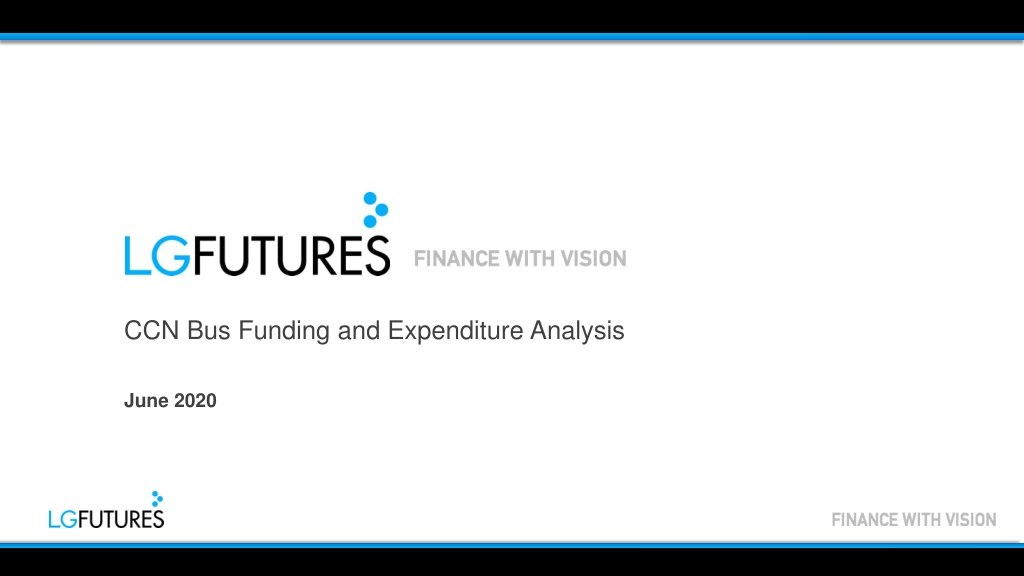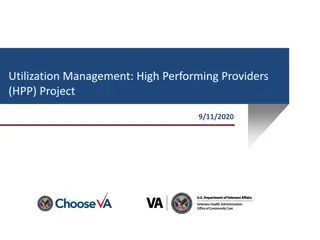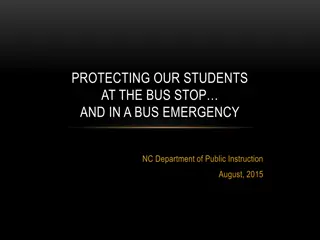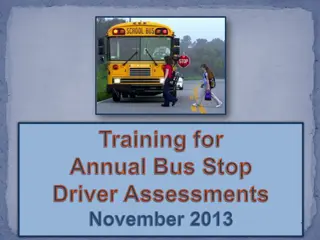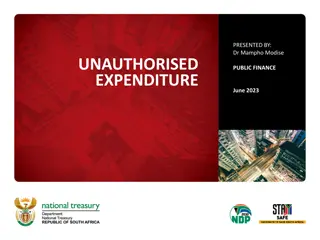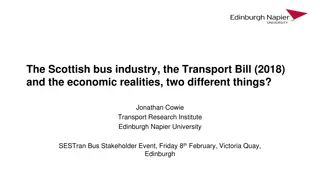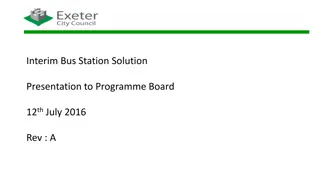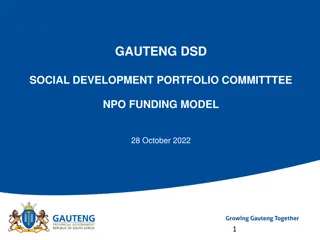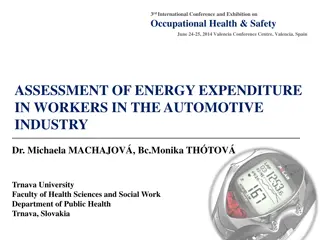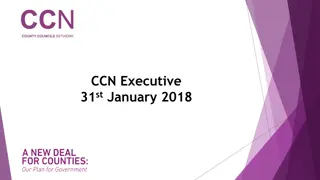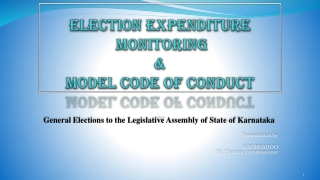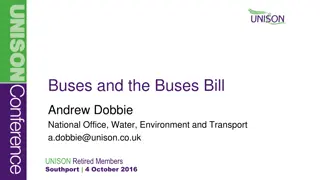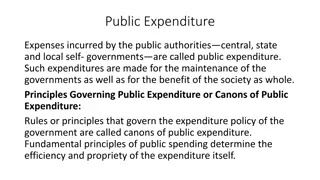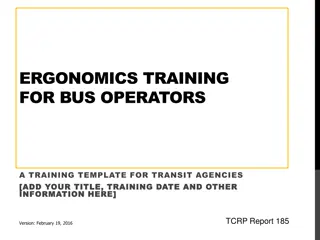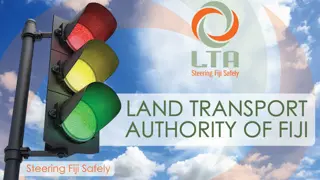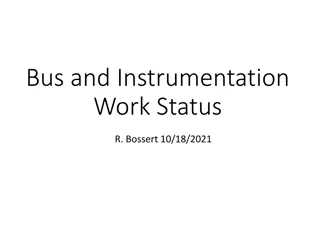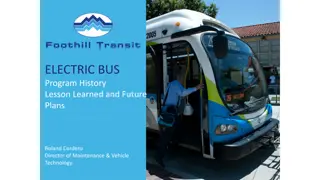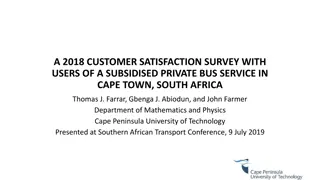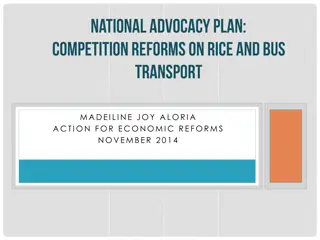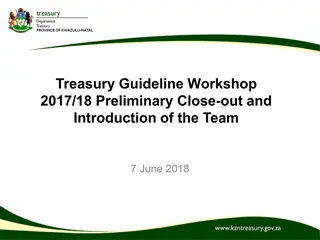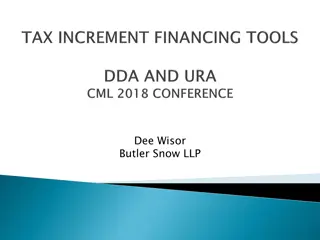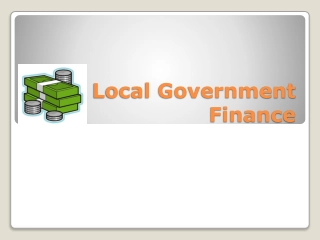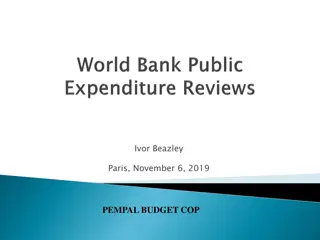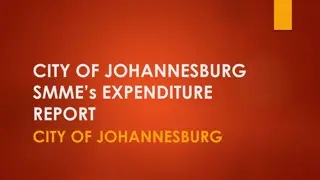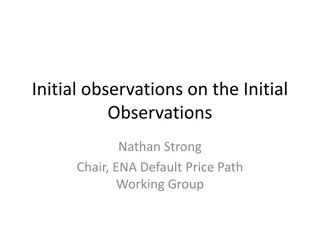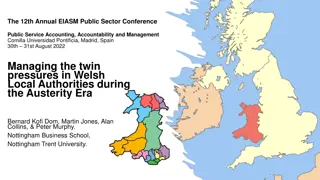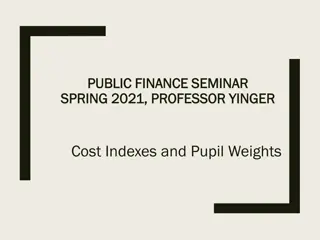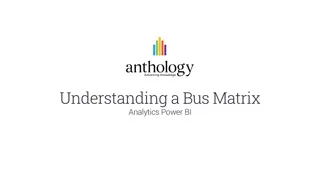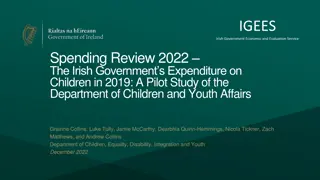Analysis of Bus Funding and Expenditure in CCN Authorities
LG Futures conducted an analysis of bus funding and expenditure for CCN authorities from 2009/10 onwards, revealing a budget gap and changes in resources. The study highlighted reductions in government support for buses, budget gaps relative to other districts, and declines in passenger journeys since 2009/10. Assumptions and conclusions were drawn based on the available data.
Download Presentation

Please find below an Image/Link to download the presentation.
The content on the website is provided AS IS for your information and personal use only. It may not be sold, licensed, or shared on other websites without obtaining consent from the author. Download presentation by click this link. If you encounter any issues during the download, it is possible that the publisher has removed the file from their server.
E N D
Presentation Transcript
Key points Resources Budget gap Service delivery COVID-19 Conclusions Assumptions CCN Bus Funding and Expenditure Analysis June 2020
Key points Key points Key points Resources Background Budget gap LG Futures was commissioned by the County Councils Network (CCN) to carry out an analysis of bus funding and expenditure, from 2009/10 onwards. Service delivery COVID-19 LG Futures identified in advance that is not possible to estimate the level of funding that currently exists for bus services. Conclusions Assumptions Instead, the level of central and local government support for bus services was used as a proxy for available resources. This is the same definition as is used by the Department for Transport (DfT) in its statistical publications. Central and local government support for buses consists of (1) net expenditure on public transport, (2) expenditure on concessionary travel, and (3) the Bus Service Operators Grant, or BSOG. LG Futures identified potential inconsistency in DfT s official figures, which could involve the double counting of BSOG as both income and expenditure. This could not be confirmed definitively, following on from correspondence with both DfT and MHCLG, and LG Futures has therefore presented the figures both inclusive and exclusive of BSOG funding. 2
Key points Key points Key points Resources Change in resources Budget gap Including BSOG, it is estimated that government support for buses in CCN authorities fell by 18.5% between 2009/10 and 2018/19. This compares to a 10.8% reduction among other unitaries & metropolitan districts, and an 18.8% reduction in London. Service delivery COVID-19 Conclusions Excluding BSOG, support for buses in CCN authorities fell by 17.6%, compared to a 7.7% reduction for other unitaries & metropolitan districts and an 8.4% reduction in London. Assumptions Given the assumptions used in the analysis, these results should be interpreted as estimates only. Comparisons with other unitaries & metropolitan districts are likely to be more meaningful than those with London, given differences in the way bus services are provided. 1 Budget gap Cost pressures were estimated based on projected population growth (2009/10 to 2018/19). For CCN authorities, cost pressures were estimated to increase by 14.9% (including BSOG) and 17.3% (excluding BSOG). This suggests that the reduction in support for buses, as described above, is more likely to reflect funding constraints than falling demand for services. 3 1. DfT notes that London runs an entirely tendered market and therefore some comparisons with the rest of country should be treated with care.
Key points Key points Key points Resources Including BSOG, the estimated budget gap for CCN authorities in 2018/19 was 33.4% of initial spending (or 222.2m). This translates to a gap of 45.0% after adjusting for inflation. Budget gap Service delivery This budget gap was significantly larger than for other unitaries & metropolitan districts (35.1% after inflation), but comparable to that of London (43.8%). COVID-19 Conclusions Excluding BSOG, the estimated budget gap for CCN authorities was 34.9% of initial spending levels (or 182.3m). This translates to a gap of 46.6% after inflation. Assumptions This budget gap was significantly larger than for other unitaries & metropolitan districts (33.8% after inflation) and London (35.0%). Service delivery Since 2009/10, the number of passenger journeys has fallen more sharply among CCN authorities than elsewhere. CCN saw a 12.1% reduction in journeys, compared with reductions of 10.0% for other unitaries & metropolitan districts and 1.8% in London. On a per capita basis, the number of journeys fell by 17.3% among CCN authorities, compared to 15.5% for other unitaries & metropolitan districts and 12.4% for London. 4
Key points Key points Key points Resources Journey time statistics (2017 data) show that accessibility for residents in CCN authorities remains lower than elsewhere. The percentage of residents who could access key services within 30 minutes, by public transport or walking, was lower on average among CCN authorities than other unitaries & metropolitan districts and lower than London. Budget gap Service delivery COVID-19 Compared to other areas, accessibility for CCN residents was lower for all 10 service categories considered by DfT. The relative lack of accessibility was greatest for (i) employment centres with 5,000+ jobs, (ii) hospitals, (iii) further education, (iv) town centres, and (v) secondary schools. Conclusions Assumptions This suggests that residents in CCN authorities may be at a greater risk of economic and social exclusion due to a lack of public transport. 5
Resources Key points Resources Resources This section presents estimates of the change in central and local government support for buses between 2009/10 and 2018/19. Budget gap Service delivery Measurement used COVID-19 LG Futures identified that it is not possible to estimate the level of funding that currently exists for bus services. Conclusions Assumptions This is because a large share of funding for bus services is allocated via the Settlement Funding Assessment (SFA). It is not possible to separately identify the share of this funding that was originally allocated for public transport support for buses, as the relevant needs assessment formula covered a range of local services.1 Instead, LG Futures has used a measure of both spending and grants. A key assumption is that changes in these resources would reflect changes in the funding available to local authorities. 1. Public transport for buses was covered by the Relative Needs Formula for upper-tier Environmental, Protective and Cultural Services (EPCS). This formula covered a range services and used generic cost drivers, rather than those specific to bus services. 6
Resources Key points Resources Resources LG Futures starting point was official statistics published by the Department for Transport (DfT). Budget gap DfT publishes national totals for central and local government support for bus services .1 This consists of three components: Service delivery COVID-19 1. Net public transport support. This is net expenditure that appears in the Revenue Outturn forms (RO2) under the line Support to operators bus services . Conclusions Assumptions 2. Bus Service Operators Grant (BSOG). This is a grant paid by central government to local authorities and commercial operators.2 3. Concessionary travel. Net expenditure on statutory and discretionary concessionary fares, excluding certain elements (such as the London Underground). DfT only publishes national or regional totals for concessionary travel and BSOG. It was therefore necessary for LG Futures to apportion these totals to the local authority level. This required a number of assumptions, which are explained in the final section of this report. Given these assumptions, the results presented here should be viewed as estimates only. 1. https://www.gov.uk/government/statistical-data-sets/bus05-subsidies-and-concessions 2. The BSOG total used by DfT excludes payments to community transport organisations. However, LG Futures estimates that the value of these payments is only 2% of that paid to commercial operators between 2010/11 and 2018/19. 7
Resources Key points Resources Resources Caveat the treatment of BSOG funding Budget gap DfT s official measurement of bus support assumes that the expenditure reported by local authorities (the first component above) is net of BSOG funding (the second component). Service delivery COVID-19 If reported expenditure is net of grant income, adding these two figures together would not involve double counting. Conclusions Assumptions However, DfT s assumption is inconsistent with MHCLG s guidance on reporting expenditure. The Revenue Outturn guidance states that grants should not be netted off reported expenditure on highways & transport. This suggests that DfT s official figures may be double counting the BSOG grant. Following queries from LG Futures, DfT statistics officers stated that this issue is difficult to get to the bottom of , and that data was not available to verify their assumption. Given the apparent inconsistency between DfT sassumptions and MHCLG s guidance, LG Futures has presented figures both inclusive and exclusive of BSOG funding. While DfT s figures have the advantage of being officially recognised1, excluding BSOG may be more methodologically sound, if authorities followed MHCLG guidance when reporting their expenditure data. 1. As well as being used in DfT s own publications, these figures are designated as National Statistics by the ONS. National Statistics must meet certain criteria; for example, they must be fit for purpose, methodologically sound, politically independent and transparently produced. 8
Resources Key points Resources Resources Resources including BSOG funding Budget gap Between 2009/10 and 2018/19, it is estimated that government support for buses fell by 18.5% among CCN members, 10.8% among other unitaries/mets and 18.8% in London.1 Service delivery COVID-19 This was a reduction of 123.0m for the CCN authorities. Conclusions Assumptions 5% Total estimated support for buses Cumulative change since 2009/10 Other unitaries / mets 0% London -5% CCN authorities -10% -15% CCN -18.5% -20% -25% -30% -35% 1. DfT notes that London runs an entirely tendered market and therefore some comparisons with the rest of country should be treated with care. 2009/10 2010/11 2011/12 2012/13 2013/14 2014/15 2015/16 2016/17 2017/18 2018/19 9
Resources Key points Resources Resources In real terms (i.e. after adjusting for inflation), CCN authorities support for buses fell by 30.1% over the same period. Budget gap Service delivery This compares to a real-terms reduction of 23.5% for other unitaries/mets, and a 30.3% reduction for London. COVID-19 Conclusions Assumptions 5% Total estimated support for buses Cumulative change since 2009/10 for CCN authorities, adjusted for inflation CCN authorities (cash terms) 0% CCN authorities (real terms) -5% -10% -15% -20% -25% -30% CCN -30.1% -35% 2009/10 2010/11 2011/12 2012/13 2013/14 2014/15 2015/16 2016/17 2017/18 2018/19 10
Resources Key points Resources Resources The chart below shows the components that contributed to the CCN authorities cash reduction of 123.0m. Budget gap Service delivery The main factor was reduced net public transport support ( 80.1m), followed by a reduction in the estimated BSOG ( 31.1m) and concessionary travel expenditure ( 11.8m). COVID-19 Conclusions Assumptions Change in support for buses - CCN authorities Cumulative change since 2009/10 (cash terms) 40m BSOG Net public transport support Concessionary travel Total government support 20m 0m - 20m - 40m - 60m - 80m - 100m - 120m - 140m 2011/12 2009/10 2010/11 2012/13 2013/14 2014/15 2015/16 2016/17 2017/18 2018/19 11
Resources Key points Resources Resources Resources - excluding BSOG funding Budget gap Excluding BSOG funding, CCN authorities support for buses falls by 17.6% over the period. This is a reduction of 91.9m, without adjusting for inflation. Service delivery COVID-19 This compares to a reduction of 7.7% for other unitaries/mets, and an 8.4% reduction for London.1 Conclusions Assumptions Total estimated support for buses, excluding BSOG funding Cumulative change since 2009/10 5% Other unitaries / mets 0% London CCN authorities -5% -10% -15% CCN -17.6% -20% -25% 1. DfT notes that London runs an entirely tendered market and therefore some comparisons with the rest of country should be treated with care. 2009/10 2010/11 2011/12 2012/13 2013/14 2014/15 2015/16 2016/17 2017/18 2018/19 12
Resources Key points Resources Resources The tables below summarise the change in support for bus services, both including and excluding BSOG funding. Budget gap Service delivery Change in estimated support for buses ( m) 2009/10 to 2018/19 CCN Other unitaries/ mets London1 England COVID-19 Conclusions Assumptions Total support inc. BSOG -123.0 -88.9 -185.0 -396.9 Total support exc. BSOG -91.9 -49.9 -73.0 -214.8 Net public transport support -80.1 -37.0 -108.4 -225.5 Concessionary travel -11.8 -12.9 35.4 10.6 BSOG -31.1 -39.0 -112.0 -182.1 CCN Other unitaries/ mets London1 England Change in estimated support for buses (%) 2009/10 to 2018/19 Total support inc. BSOG -18.5% -10.8% -18.8% -16.1% Total support exc. BSOG -17.6% -7.7% -8.4% -10.5% Net public transport support -39.4% -20.9% -15.7% -21.1% 1. For London, BSOG funding was devolved to TfL part-way through 2013/14, and would subsequently be reflected under net public transport support. Concessionary travel -3.7% -2.8% 19.3% 1.1% BSOG -21.8% -22.3% -100.0% -42.3% 13
Resources Key points Resources Resources Annex A presents the figures above, as well as estimates for each CCN member authority. Budget gap It is emphasised that these are estimates only. They are unlikely to match the actual resources allocated to bus services at the individual authority level. This is mainly due to BSOG funding, for which consistent local authority data was not available for period in question. Service delivery COVID-19 Conclusions LG Futures has apportioned national BSOG totals to the authority level using bus mileage, similar to the method used by DfT to estimate totals for London and other areas. Assumptions 14
Budget gap Key points Resources LG Futures compared authorities decline in resources with an estimate of their spending need (or cost pressures), to arrive at an estimate of their budget gap. Budget gap Budget gap Service delivery Cost pressures for bus service were assumed to increase in line with each authority s projected population. COVID-19 Conclusions Costs for concessionary travel were assumed to increase in line with the projected number of residents aged 65 and over.1 Assumptions Overall, LG Futures estimates a budget gap of 33.4% for the CCN authorities (relative to initial spending levels), or 222.2m. This budget gap increases to 45.0% after adjusting for inflation. If BSOG funding is excluded, the estimated budget gap is 34.9% of initial spending, or 182.3m. This increases to 46.6% after inflation. The CCN authorities budget gap is greater than other unitaries/mets and London, particularly if BSOG funding is excluded from the analysis. 1. Concessionary travel includes discretionary spending which, unlike statutory concessions, may not be targeted primarily at older adults. However, expenditure on statutory concessions accounted for 88% of the total in 2013/14, the first year in which the data was disaggregated between statutory and discretionary. For this reason, older adults have been used for the purpose of this analysis. 15
Budget gap Key points Resources Budget gap including BSOG funding Budget gap Budget gap Between 2009/10 and 2018/19, CCN authorities are estimated to have seen an increase in cost pressures for bus services and concessionary travel of 14.9%. Service delivery COVID-19 The increase in population (and cost pressures) suggests that the reduction in spending on local buses is more likely to reflect funding constraints than declining demand. Conclusions Assumptions Estimated budget gap for CCN authorities Relative to expenditure in 2009/10 20% 10% Costs +14.9% 0% -10% -20% -30% Additional costs -40% 2009/10 2010/11 2011/12 2012/13 2013/14 2014/15 2015/16 2016/17 2017/18 2018/19 16
Budget gap Key points Resources This was combined with a reduction in resources, or central and local government support, of 18.5%, as described in the previous section. Budget gap Budget gap Service delivery This corresponds to a budget gap of 33.4% (as a proportion of initial spending), or 222.2m. COVID-19 Conclusions Assumptions Estimated budget gap for CCN authorities Relative to expenditure in 2009/10 20% 10% Costs +14.9% 0% Budget gap 33.4% or 222.2m Resources -18.5% -10% -20% -30% Additional costs Resources (cash terms) -40% 2009/10 2010/11 2011/12 2012/13 2013/14 2014/15 2015/16 2016/17 2017/18 2018/19 17
Budget gap Key points Resources Adjusted for inflation, this budget gap increases to 45.0%, or 348.5m (in 2018/19 prices). Budget gap Budget gap Service delivery COVID-19 Conclusions Assumptions Estimated budget gap for CCN authorities Relative to expenditure in 2009/10, adjusted for inflation 20% 10% Costs +14.9% 0% Budget gap 45.0% or 348.5m Resources -30.1% -10% -20% -30% Additional costs -40% Resources (real terms) 2009/10 2010/11 2011/12 2012/13 2013/14 2014/15 2015/16 2016/17 2017/18 2018/19 18
Budget gap Key points Resources CCN s estimated budget gap of 45.0% (inflation adjusted) is significantly larger than other unitaries/mets (35.1%), and slightly larger than London (43.8%). Budget gap Budget gap Service delivery Compared to other unitaries/mets, CCN authorities saw both a larger reduction in resources and a larger increase in cost pressures. COVID-19 Conclusions Assumptions Estimated budget gap by authority group Relative to expenditure in 2009/10, adjusted for inflation 50% 45.0% 43.8% Change in costs Change in resources Budget gap 40% 35.1% 30% 20% 14.9% 13.5% 11.6% 10% 0% -10% -20% -23.5% -30% -30.1% -30.3% -40% CCN authorities Other unitaries / mets London 19
Budget gap Key points Resources Budget gap excluding BSOG funding Budget gap Budget gap If BSOG funding is excluded from the analysis, CCN authorities see an increase in costs of 17.3% between 2009/10 and 2018/19. Service delivery COVID-19 Conclusions Assumptions Estimated budget gap for CCN authorities excluding BSOG funding Relative to expenditure in 2009/10 20% 10% Costs +17.3% 0% -10% -20% -30% Additional costs -40% 2009/10 2010/11 2011/12 2012/13 2013/14 2014/15 2015/16 2016/17 2017/18 2018/19 20
Budget gap Key points Resources This was combined with a reduction in resources of 17.6%, as described in the previous section. Budget gap Budget gap Service delivery This translates to a budget gap of 34.9% (as a proportion of initial spending), or 182.3m. COVID-19 Conclusions Assumptions Estimated budget gap for CCN authorities excluding BSOG funding Relative to expenditure in 2009/10 20% 10% Costs +17.3% Budget gap 34.9% or 182.3m 0% Resources -17.6% -10% -20% -30% Additional costs Resources -40% 2009/10 2010/11 2011/12 2012/13 2013/14 2014/15 2015/16 2016/17 2017/18 2018/19 21
Budget gap Key points Resources Adjusted for inflation, this translates to a budget gap of 46.6%, or 283.4m. Budget gap Budget gap Service delivery COVID-19 Conclusions Assumptions Estimated budget gap for CCN authorities excluding BSOG funding Relative to expenditure in 2009/10, adjusted for inflation 20% 10% Costs +17.3% 0% Resources -29.3% Budget gap 46.6% or 283.4m -10% -20% -30% Additional costs -40% Resources (real terms) 2009/10 2010/11 2011/12 2012/13 2013/14 2014/15 2015/16 2016/17 2017/18 2018/19 22
Budget gap Key points Resources Excluding BSOG funding, CCN s estimated budget gap of 46.6% (after inflation) is significantly larger than both other unitaries/mets (33.8%) and London (35.0%). Budget gap Budget gap Service delivery CCN authorities budget gap is therefore larger, relative to other authorities, when BSOG funding is excluded from the analysis. COVID-19 Conclusions Annex B provides the estimated budget gap (in cash terms) for individual CCN members. Assumptions 60% Estimated budget gap by authority group, excluding BSOG funding Relative to expenditure in 2009/10, adjusted for inflation Change in costs Change in resources Budget gap 46.6% 50% 40% 35.0% 33.8% 30% 17.3% 20% 13.7% 13.0% 10% 0% -10% -20% -20.8% -21.4% -30% -29.3% -40% CCN authorities Other unitaries / mets London 23
Service delivery Key points Resources LG Futures assessed whether there was other evidence for changes in service delivery over time. The analysis was limited by the availability of authority-level data which covered the time period in question. Budget gap Service delivery Service delivery COVID-19 The best available metric was the number of passenger journeys1, for which data was available from 2009/10 to 2018/19. This was used to demonstrate how the number of passenger journeys, and passenger journeys per resident, have changed over time. Conclusions Assumptions Data was also available on journey times.2 One useful measurement is the percentage of residents who can reach key services (such as employment, education, and medical care) within a given time period; for example, within 30 minutes. However, this data was only available for a short period (2014/15 to 2017/18) and so was only useful for comparing levels, rather than changes over time. These two measurements are discussed in the remainder of this section. 1. DfT, Passenger journeys on local bus services by local authority, England, from 2009/10 , Table BUS0109a 2. Dft, Journey Time Statistics: 2017 (Revised) , Tables JTS0401 to JTS0408 24
Service delivery Key points Resources Passenger journeys: Between 2009/10 and 2018/19, CCN authorities saw a 12.1% reduction in the annual number of bus journeys, as shown below. Budget gap Service delivery Service delivery This was greater than the reduction seen in other unitaries/mets (10.0%) and London (1.8%), and the England average of 6.4%. COVID-19 Conclusions Assumptions 0% Change in passenger journeys Between 2009/10 and 2018/19 Passenger journeys -2% Passenger journeys per resident -1.8% -4% -6% -6.4% -8% -10% -10.0% -12% -12.1% -14% -16% -18% -20% CCN Other unitaries / mets London England authorities 25
Service delivery Key points Resources Looking at the passenger journeys per resident, CCN authorities saw a 17.3% reduction. Budget gap While the differences were less pronounced, this was again larger than the reductions seen for other unitaries/mets (15.5%), London (12.4%) and England as a whole (12.7%). Service delivery Service delivery COVID-19 Annex C includes the change in passenger journeys for individual CCN members. Conclusions Assumptions 0% Change in passenger journeys Between 2009/10 and 2018/19 Passenger journeys -2% Passenger journeys per resident -4% -6% -8% -10% -12% -12.4% -12.7% -14% -16% -15.5% -18% -17.3% -20% CCN Other unitaries / mets London England authorities 26
Service delivery Key points Resources Journey times to key services: The chart below shows the percentage of residents who could access key services by public transport or walking within 30 minutes (for 2017). This was lower among CCN authorities than for other unitaries/mets and London for every service. Budget gap Service delivery Service delivery COVID-19 As described above, there was insufficient data available to assess whether journey times had changed over time. Conclusions Assumptions Journey times to key services % of residents able to access services by public transport or walking within 30 minutes (2017) 100 CCN 80 Other unitaries / mets London 60 40 20 0 GP Town centre Hospital Employment centre Food store Primary school Secondary school Employment centre (100 Employment centre (500 Further education (5000+ jobs) to 4999 jobs) to 499 jobs) 27
Service delivery Key points Resources The proportion of CCN residents who could access services within 30 minutes was lowest, in relative terms, for the following services: Budget gap Service delivery Service delivery Employment centres with 5,000+ jobs (37% of CNN residents, vs 69% for other unitaries/mets and 82% for London); COVID-19 Conclusions Hospitals (26% of CCN residents, vs 40% for other unitaries/mets and 65% for London); Assumptions Further education (74% of CNN residents, vs 90% for other unitaries/mets and 99% for London); Town centres (79% of CCN residents, vs 90% for other unitaries/mets and 99% for London); and Secondary schools (83% of CCN residents, vs 97% for other unitaries/mets and 100% for London). These show that residents in CCN authorities may be at the greatest risk of economic and social exclusion due to a lack of public transport, particularly in households without access to cars or other personal transport. 28
Potential COVID-19 implications Key points Resources This section considers the possible financial impact of COVID-19 on local bus services. Budget gap The effects are likely to be diverse and complex. This includes the change in demand for bus services (e.g. due to remote working, business closures and social distancing), the supply of bus services (e.g. reduced bus capacity to enable physical distancing), and direct costs (such as PPE and additional cleaning). Service delivery COVID-19 COVID-19 Conclusions Assumptions Other factors include the composition of local businesses (e.g. reliance on retail and tourism), the profile of current bus usage (e.g. the proportion of rural routes, current occupancy rates, and the proportion of older adult passengers and pupils), and the contractual arrangements between local authorities and local bus operators. Given the number of variables, and the lack of data at the local authority level, LG Futures does not believe that it is possible to estimate precisely the financial impact at the local authority level. Instead, LG Futures has developed a simple model to identify a theoretical range of costs facing local bus services in CCN authorities. By necessity, such a model is simplified in nature and reliant on the assumptions specified by the user. 29
Potential COVID-19 implications Key points Resources The model is based on four key user inputs/assumptions: Budget gap 1. The reduction in demand for local bus services, or passenger journeys, as a percentage of current demand. A proportional reduction in fare receipts is assumed. Service delivery COVID-19 COVID-19 2. How the reduction in passenger journeys translates to a change in bus journeys. The number of bus miles is expected to fall by a smaller proportion than passenger journeys as (1) many routes will continued to operate at lower bus occupancy rates, (2) the number of journeys on some routes may increase to offset reduced bus capacity limits, and (3) some routes with very few passengers may be prioritised; for example, those in rural areas. Conclusions Assumptions 3. The share of fixed vs. variable costs. Fixed costs include administrative costs and other overheads. These are assumed not to change in the short run. Variable costs such as fuel, maintenance and some driver wages are assumed to fall in direct proportion to the reduction in bus mileage. The larger the variable cost share, the larger the reduction. 4. Additional direct costs (such as PPE and sanitation), expressed as a percentage of total operating costs. The financial impact is modelled for the CCN area as a whole. This includes the impact on the local authority, LA supported bus services, and commercial operators. 30
Potential COVID-19 implications Key points Resources To illustrate, the table below shows the range of impacts for scenarios in which passenger journeys fall by 25%, 50% and 75%. Fixed costs are assumed to account for either 10%, 25% or 50% of total costs. Budget gap Service delivery COVID-19 COVID-19 Every 10% reduction in passenger journeys is assumed to translate to a 5% reduction in bus mileage on commercially operated routes, and a 2.5% reduction on LA supported routes (these are assumed to be prioritized, despite falling demand). Conclusions Assumptions Based on this set of assumptions, the financial impact on the CCN area could be between 133.6m and 607.1m, as shown in the table below. Potential range of impacts on local bus services Assumes every 10% fall in passenger journeys translates to: 5.0% mileage on commercially operated routes 2.5% mileage on LA supported routes Direct costs (PPE etc.) are assumed to be 1% of operating costs, or 17.5m. Reduction in passenger journeys 25% 50% 75% Fixed : variable 10% : 90% 133.6m 249.8m 366.0m Proportion of fixed to variable costs 25% : 75% 163.8m 310.1m 456.4m 50% : 50% 214.0m 410.6m 607.1m 31
Conclusions Key points Resources LG Futures estimates that CCN authorities have seen a greater reduction in funding and a larger increase in cost pressures (based on population) than other unitaries & metropolitan districts. This has resulted in a larger budget gap emerging for CCN authorities since 2009/10. Budget gap Service delivery COVID-19 The exact size of the budget gap (and whether it is bigger than London) depends on whether BSOG funding is included or not. Conclusions Conclusions Assumptions An advantage of using DfT s figures, which include BSOG, is that these are officially recognised and used in DfT s own statistical reports.1 However, excluding BSOG would be justified if authorities reported expenditure was gross of this grant, consistent with MHCLG guidance. If this were the case, it would be correct to exclude BSOG funding to avoid double counting. The change in resources for local bus services should be considered estimates only. Assumptions include the use of expenditure as a proxy for funding and the apportionment of national and regional totals to the local authority level. CCN authorities saw a sharper reduction in passenger journeys since 2009/10, in terms of total journeys and on per capita basis, which may reflect funding constraints. 1. For example: DfT, Annual bus statistics: year ending March 2019 , https://www.gov.uk/government/statistics/annual-bus-statistics- year-ending-march-2019 32
Assumptions Key points Resources This section sets out key assumptions that were used in the analysis. Budget gap Government support as a proxy for funding Service delivery LG Futures identified that it is not possible to estimate the level of funding that currently exists for bus services. COVID-19 Conclusions Assumptions Assumptions This is because a large share of funding for bus services is allocated via the Settlement Funding Assessment (SFA). Previously, this was allocated in the form of Formula Grant; this was subsequently rolled into SFA in 2013/14. While the Formula Grant included funding for public transport support for buses , it is not possible to identify the share of an authority s assessed needs (and therefore funding) that was attributable to this service.1 Instead, LG Futures based this analysis on central and local government support for bus services , using the same definition as the Department for Transport (DfT) in its Annual Bus Statistics reports.2 This includes a combination of net expenditure on bus services and grant funding. 1. Funding for buses was part of the needs assessment formula for upper-tier Environmental, Protective and Cultural Services (EPCS). Relative needs for buses was not separately identified within this formula, which covered a number of services. 2. DfT Annual bus statistics: year ending March 2019 , 17 Dec 2019. https://www.gov.uk/government/statistics/annual-bus-statistics- year-ending-march-2019 33
Assumptions Key points Resources Specifically, DfT s measure of support for bus services includes: Budget gap Net public transport support net expenditure that appears in the Revenue Outturn forms under the line Support to operators bus services . Service delivery COVID-19 Bus Service Operators Grant (BSOG) a grant paid by central government to local authorities and commercial operators.1 Conclusions Assumptions Assumptions Concessionary travel net expenditure on statutory and discretionary concessionary fares, as published in the Revenue Outturn forms, but excluding certain services (e.g. the London Underground). Government support for buses is therefore not only a measurement of funding (BSOG), but also net expenditure. It is necessary to assume that net expenditure is a suitable proxy for need-to-spend on bus services, and that reductions in local authority expenditure will reflect underlying reductions in funding. 1. The BSOG total used by DfT excludes payments to community transport organisations. However, LG Futures estimates that the value of these payments is only 2% of that paid to commercial operators between 2010/11 and 2018/19. 34
Assumptions Key points Resources Treatment of BSOG funding Budget gap As explained in the Resources section of this report, DfT s measure of government support for buses assumes that authorities reported expenditure is net of BSOG funding. This avoids double counting this funding as both income and expenditure. Service delivery COVID-19 Conclusions However, this assumption is inconsistent with MHCLG s guidance in the Revenue Outturn forms, from which the expenditure data is sourced. The guidance specifies that grant income should not be netted off expenditure related to highways and transport. Assumptions Assumptions It is therefore possible that DfT could be double counting BSOG funding in its measurement of government support for local buses. LG Futures was unable to rule this out, following correspondence with DfT statistical officers and through a review of available expenditure and grant data. For this reason, the report presents figures both inclusive and exclusive of BSOG. 35
Assumptions Key points Resources Apportioning grants and expenditure to individual authorities Budget gap The third set of assumptions relate to how BSOG funding and concessionary travel expenditure is apportioned to the local authority level. Service delivery COVID-19 A limitation of DfT s figures is that they are only published at the national level. Only the component net public transport support is available at the local authority level. For the other two components concessionary travel and BSOG it was necessary to make assumptions to apportion these to the individual authority level, and hence to calculate the total for CCN authorities. Conclusions Assumptions Assumptions Given these assumptions, the values presented in this report should be considered as estimates only. The assumptions used to apportion expenditure/funding to the local authority level, for concessionary travel and BSOG, is described in the following slides. 36
Assumptions Key points Resources (i) Apportioning concessionary travel Budget gap DfT s measurement of government support includes concessionary travel. The national totals published by DfT exclude certain elements, including the London Underground, Mersey Ferries and Rail, and West Yorkshire PTE Rail and Light Rail Systems. Service delivery COVID-19 Conclusions To estimate these values at the local authority level, LG Futures used the figures published for individual authorities and combined authorities in the Revenue Outturn form. Assumptions Assumptions The Revenue Outturn figures were scaled to the totals published by DfT. The totals published by DfT related to (1) London, (2) metropolitan areas , a grouping of six combined authorities, and (3) all other local authorities in England. In other words, expenditure for individual authorities or combined authorities (as published in the Revenue Outturn) was scaled at one of three different rates, depending on which of these groups they belong to. 37
Assumptions Key points Resources (ii) Apportioning Bus Service Operators Grant (BSOG) Budget gap BSOG is a subsidy provided by central government to operators of local bus services. Service delivery As part of its measurement of government support for buses, DfT only published BSOG totals at the national level. It also publishes totals for the three major groups (London, metropolitan areas and non-metropolitan areas), but these are estimated by distributing the national total based on reported bus mileage. COVID-19 Conclusions Assumptions Assumptions LG Futures has further apportioned these group totals to the individual authority level using a similar method to DfT. This was based on bus mileage for each individual authority in 2018/19 (the only year for which data was available). Given these assumptions, estimates of BSOG at the local authority level are likely to be the least robust of the three components of government support discussed here. 38
Assumptions Key points Resources Durham and Northumberland Budget gap An additional step was required to estimate expenditure on net public transport support for Durham and Northumberland (both CCN members). Service delivery COVID-19 These authorities are now part of The Durham, Gateshead, Newcastle, North Tyneside, Northumberland, South Tyneside and Sunderland Combined Authority . Conclusions Assumptions Assumptions DfT reported expenditure on net public transport support for Durham, Northumberland and the combined authority, for each year from 2009/10 and 2018/19. It is unclear how much expenditure, if any, was being carried out by the combined authority on behalf of Durham and Northumberland. To ensure consistency, LG Futures aggregated all the expenditure of the combined authority and its members in each year. The total expenditure was then distributed to each member authority based on its relative population size. Durham and Northumberland are the only CCN authorities for whom these estimates were necessary. 39
